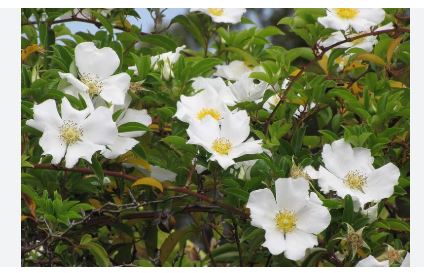
Rosa laevigata, commonly known as the Cherokee Rose, is part of the Rosa genus within the Rosaceae family, which encompasses a wide variety of plants including roses, apples, and strawberries. This species is distinguished by its evergreen nature in mild climates, large, white, fragrant flowers, and an abundance of sharp thorns. The species name “laevigata” refers to the smooth, glossy texture of its leaves.
The Cherokee Rose is native to China and Taiwan, with its natural habitat extending to parts of Southeast Asia. It was introduced to the southeastern United States, where it has naturalized, particularly in Georgia, Alabama, and surrounding states. In its native and introduced ranges, it thrives in various habitats but prefers well-drained soils in full sun to partial shade.
The history of Rosa laevigata in North America is intertwined with the Trail of Tears, the forced relocation of the Cherokee Nation in the 19th century. According to legend, the Cherokee rose sprung up along the route of this tragic journey, symbolizing hope and resilience. It was named the state flower of Georgia in 1916, reflecting its cultural significance in the region. However, despite its name and cultural association, it’s not originally from Cherokee territory but was introduced from Asia. In its native China, it has been used in traditional medicine and for ornamental purposes. Its vigorous growth has made it both a beloved garden plant and, in some areas, an invasive species due to its ability to spread quickly.
Cherokee Rose is well-adapted to USDA Hardiness Zones 7 through 9, indicating its preference for warmer climates where it can grow as an evergreen. In colder zones, it might lose its leaves or not survive without protection. This plant can live for many years, with some specimens reaching over 30 years in favorable conditions. Its longevity is supported by its ability to produce suckers and its robust growth habit, although in cultivation or naturalized settings, its lifespan can vary based on environmental conditions, disease, and management.
Cherokee Rose (Rosa laevigata): Characteristics
- Flower Appearance: Produces large, solitary white flowers, typically 2-3 inches in diameter, with a yellow center of stamens. Flowers are highly fragrant, often blooming in spring with some repeat blooming throughout the season.
- Bloom Time: Primarily blooms in late spring to early summer, with potential for sporadic blooms later in the year, providing a long flowering period.
- Growth Habit: An evergreen shrub or climbing plant in warmer climates, capable of growing up to 20 feet tall with support or forming dense thickets as a shrub. It features a vigorous, spreading habit via suckers.
- Leaves: Leaves are glossy, dark green, and nearly evergreen in mild climates, composed of three to five leaflets per leaf, with each leaflet being oval to elliptical in shape.
- Thorns: Notable for its large, curved thorns which are sharp and densely packed along the stems, providing both protection and a challenge for handling.
- Root System: Has an extensive root system with the ability to produce suckers, which can lead to the plant spreading widely and becoming invasive in some environments.
- Adaptability: Adapts well to a variety of soil types but prefers well-drained, fertile soils. It tolerates both full sun and partial shade, though flowering is best with more sunlight.
- Fruit: After flowering, it produces bright red, oval hips (fruits) which persist into winter, offering ornamental value and a food source for wildlife.
- Cultural Significance: Symbolically linked to the Trail of Tears and adopted as the state flower of Georgia, embodying resilience and cultural significance despite not being native to the Americas.
- Ecological Impact: While valued for its beauty and fragrance, its aggressive growth can make it invasive in non-native regions, where it might outcompete local flora, potentially leading to ecological imbalances if not managed.
Cherokee Rose (Rosa laevigata): Cultivation
Site Selection
Choose a location with full sun to partial shade. Cherokee Rose blooms best with at least 6 hours of direct sunlight but can tolerate some shade, particularly in hotter climates.
Soil Preparation
Prefers well-drained, fertile soil but can adapt to a range of soil types. Enrich the soil with organic matter to improve fertility and drainage, especially if the soil is heavy or sandy.
Planting
Plant in spring or fall. Dig a hole twice as wide as the root ball but not deeper. If planting for climbing, provide a sturdy support structure. Space plants 6 to 10 feet apart due to their spreading habit.
Watering
Water deeply after planting to establish roots. Once established, it’s somewhat drought-tolerant but benefits from regular watering during dry spells, especially during the first year.
Mulching
Apply a layer of organic mulch around the base to conserve soil moisture, suppress weeds, and regulate soil temperature. Keep mulch away from the stem to prevent rot.
Fertilization
Fertilize in early spring with a rose-specific or balanced slow-release fertilizer. Avoid high-nitrogen fertilizers which can promote foliage at the expense of flowers.
Pruning and Maintenance
Prune in late winter or early spring before new growth begins. Remove dead or diseased wood, and thin out crowded areas to promote air circulation. Wear gloves to handle its thorns. Control spread by removing suckers.
Pest and Disease Management
Watch for common rose pests like aphids, spider mites, and diseases such as black spot or powdery mildew. Ensure good air flow, use fungicides if necessary, and consider resistant varieties if available.
Propagation
Propagate by softwood cuttings in summer, hardwood cuttings in winter, or by layering. Seeds can be used, but plants from seeds might not retain desired traits and take longer to flower.
Winter Care
In USDA Zones 7-9, minimal winter care is needed; however, in the colder end of this range, mulch around the base to protect roots from frost. In areas where it’s deciduous, prune back any dead wood in late winter.